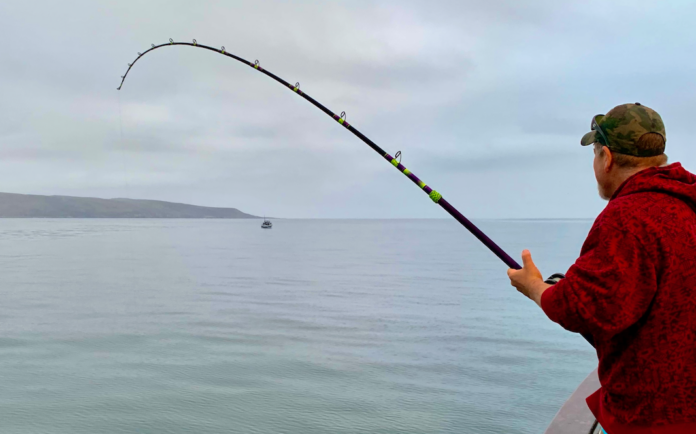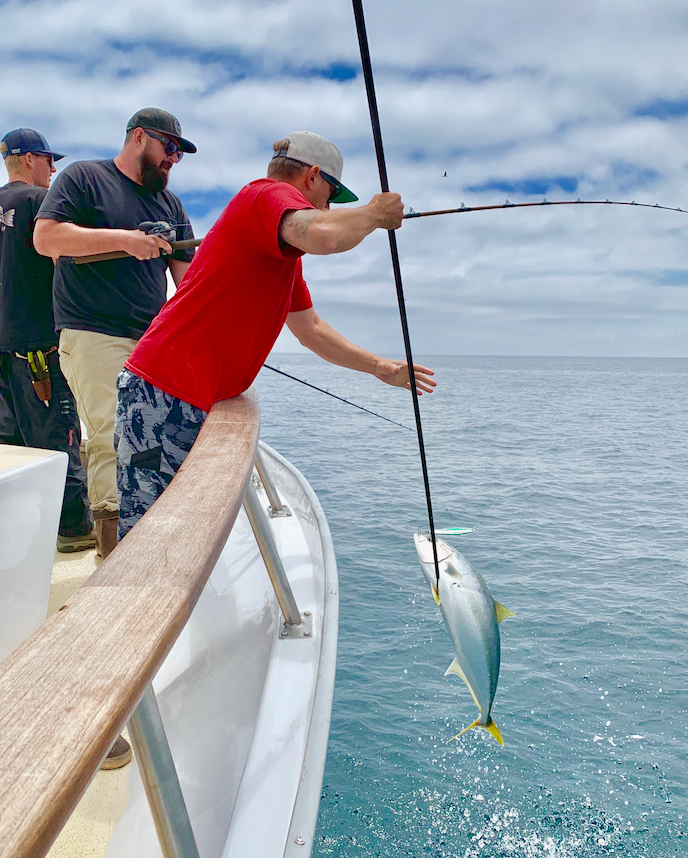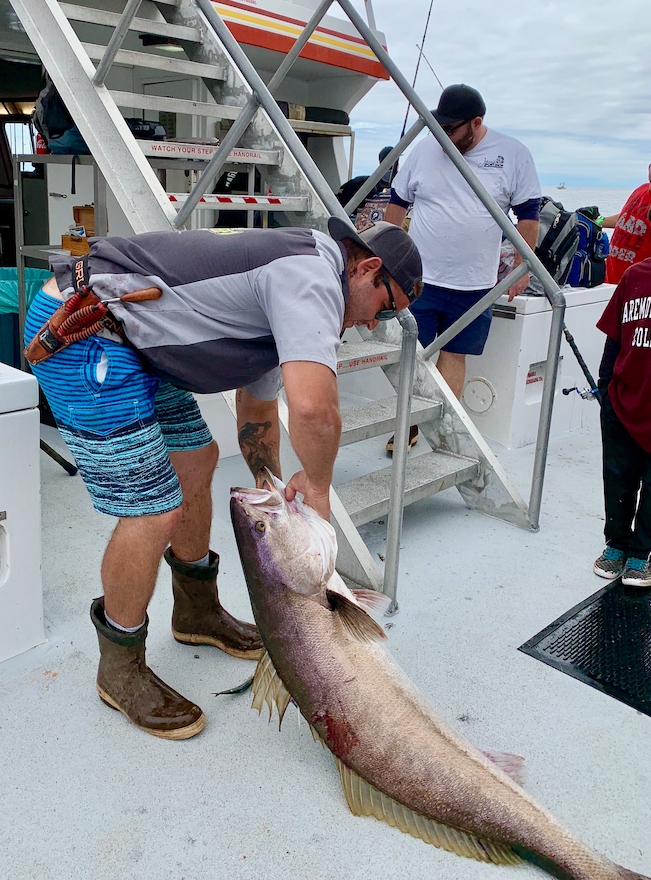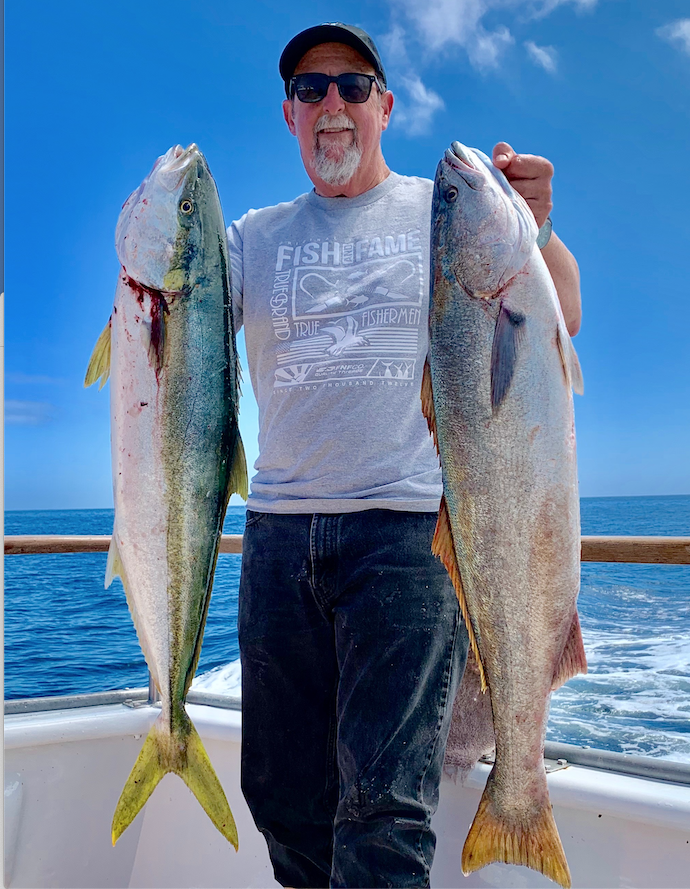
BY JON DICKENS
White seabass. Croaker. Chrome. Ghosts. Whatever name you know them by, they may be the most frustratingly difficult fish to find and catch in Southern California. Thousands of anglers with decades of experience who have caught everything from blue perch to bluefin tuna have yet to check the white seabass box on their bucket list. If you’re among them, or just want some tips on how to catch a few more, read on.
Before getting into techniques, be aware that the minimum size for keeping white seabass is 28 inches. That size fish is roughly five years old, weighs in at about 7 to 8 pounds and has had at least one season of spawning under its belt. The hatchery programs that have been going on for some years now have been quite successful. They have grow-out pens maintained in local harbors and have accounted for thousands of fish being released into the wild. Average seabass caught range from 12 to 40 pounds, with fish exceeding 60 pounds not uncommon.
Why are white seabass so hard to catch?
There are two basic ingredients to catching white seabass. First is finding them, and second is getting them to bite. Pretty basic, but just when you think you’ve figured something out, they change things up and… disappear. Which is why they’re called ghosts. While there are always seabass swimming around, they don’t school up and bite in earnest until spring. By late summer, they pretty much say, See ya’ next year.
Where are the best locations to find white seabass?
Seabass can show up locally along the coast, and there are a handful of six-pack charter captains that have become experts at catching them there. However, many more fish are caught at the outer islands of Catalina, San Clemente, San Nicolas and Santa Barbara, with the best concentration of fish over the last decade being taken at the Channel Islands. If I had only one trip I could take for seabass, that’s where I’d go.
When’s the best time to catch seabass?

Seabass are notoriously nighttime and grey light feeders, although they can still be caught in daylight hours. The boats that often score best are overnight or full-day boats that get on the grounds before daybreak and still have plenty of daylight to fish. When the fish are on the chew, those party boats fishing the Channel Islands fill up fast.
The other consideration has to do with moon phase. Many people say three days before and after a new moon or full moon is best, primarily because of the increased tidal flow. Moving water gets the fish feeding. Current, going in the right direction, is probably the most critical factor to finding feeding fish, along with locating squid nests. When water temps draw squid into the islands in the spring, finding spawning squid is key. Known as the candy bait, seabass along with yellowtail and halibut slurp up the candy like a kid in a… well, you know.
What’s the best way to fish with squid?
Squid can be fished either live or fresh-dead. Frozen generally doesn’t cut it. Sometimes, boats will already have it in their bait tanks and sometimes they’ll try to catch it on or near the fishing grounds using bright lights to draw them to the surface where they’re netted. If there isn’t a concentrated school of squid, multi-pronged squid jigs are used by crew and anglers to snag as much as possible.
Unlike fishing fin bait, where you search out the fastest swimming bait in the bait wells, that’s not important for seabass. Many believe fresh-dead outperforms live squid because the seabass are lazy and don’t want to chase down their meal. Some anglers throw a live squid on the deck to stun it before hooking it. You also don’t need to reel in and check your squid as often as live fin bait. You want to be in the water as much as possible because sometimes the fish will swim through and the bite will last but a few minutes. If you’re out of the water changing your squid, you lose.
The most popular way to fish squid is on a single dropper loop rig. The key is keeping your bait several feet above the bottom to avoid it being eaten by bat rays and other bottom-huggers eating the spawned out squid. When tying your rig up, put an 8-ounce torpedo sinker on the bottom and tie your dropper loop at about waist or chest high as you hold it. The loop should be 6- to 10-inches long and is usually tied with a surgeon’s knot. For your hook, use an Owner Aki Twist, a longer shank J-hook with a twist or bend in the shank. Simply thread the doubled loop through the eye of the hook and over the top of it, or attach the hook to the loop with a Palomar knot. Match your hook size to the size of the squid. Most often that will be a 5/0- to 8/0 hook, which should be woven through the pointy end of the squid several times to keep it on.
While seabass are generally not line-shy, fluorocarbon leaders will give added abrasion resistance to your dropper loop rig, and at times will get you more bites. Generally 25- to 40-pound test is used, with heavier line employed at night.
Your main line can be either braid connected to the dropper loop rig, known as a “kelp-cutter” rig because the braided line can cut through kelp if your seabass swims into it, or braid with a short topshot of monofilament tied to your dropper loop. The advantage of the mono is it stretches. Seabass have tender mouths and the added stretch can keep you from pulling the hook. That’s also why most people fish a more parabolic rod with a soft tip. Seabass employ violent headshakes to throw the hook. If you’re fishing braid straight to the leader, this is even more important. You need to have some give to prevent losing fish. Setting your drag a little lighter than usual is also wise. If you’re not sure how to set it, ask a crewmember.

What are some tips that will help me catch that elusive ghost?
- If the boat is chasing the seabass, meaning the fish aren’t holding in one spot and the captain is searching for a school, consider an alternative method of rigging your squid. Try a sliding egg sinker above your hook, 1/8- to ¾-ounce depending upon the depth and current, instead of a dropper loop rig. Cast it out to fish the upper and mid-level depths of the water column for moving fish. You can also try a leadhead jig with a long shank hook to pin your squid on. This also applies when the boat’s anchored up and no one’s getting bit on the bottom. And try the glow-in-the-dark varieties if you’re fishing in the dark.
- Seabass are often nibblers. You may feel something pecking at your bait. Could be perch or other small fish that will attract a seabass, or the seabass itself. Sometimes they peck at the squid before swallowing it. DON’T swing when you feel the pecks. Wait for the line to come tight and the rod to load up and wind into the fish so you don’t pull the bait away from it.
- When you hook up, don’t pump the rod and pull hard. Straight-wind it or gently pump your rod, with no slack in your line that the fish can use to throw the hook, and keep your fish in front of you. Follow it when it moves, winding as you walk.
- If the boat is moving and the captain says he’s metered some fish and get ready — be ready to drop as soon as he says go. White seabass are a fish of limited opportunity. The window opens and closes quickly. I’ve been on trips where the only bite lasted all of 10 minutes and being the ghosts that they are, the seabass then disappeared. Another trick is using a sinker that’s a little heavier than what most are using so that you’re the first one to get down to the fish.
- Sometimes the seabass respond to a different bait or presentation. The hot ticket on a few boats this spring has been the Redemption white Fluke on a leadhead. A couple seasons ago, I was on a charter aboard the Aloha Spirit from Oxnard and the seabass were keyed in on red crabs. Captain Shawn Steward had the deckhands on the bow looking for the dorsal fins and tails of the seabass on the surface scooping up the red crabs, like tailing bonefish or redfish. We’d slide in on them and throw red crab colored Hookup Baits. Shawn said, “If you feel even a slight tap, SWING!” Most of the seabass caught that day, and during the season, were on the red crab Hookup Bait and there was a run on tackle shops for them.
- On private boats, sometimes the best angler is the rod holder. Drop a heavy white jig with a single hook laced with two squid on it down to the bottom, crank it up a few feet, and let it sit in the rod holder. The gentle rock of the boat moves the jig and squid and simulates spawning squid. I’ve caught a couple nice seabass in local waters drifting over squid nests this way.
- In late spring or early summer, if the barracuda and sand bass show up and are mauling bird schools of anchovies, white seabass often join the party. Try throwing a mackerel into the fray. A sardine or ‘chovy will likely get eaten by the barries or bass, but the mackerel will stand out like juicy filet mignon to a seabass.
What’s the single most important thing that most anglers do wrong?
Easy. Not listening to the crew. Conditions change and every day is different. And every boat fishes for seabass a little differently. Listen to the guys that are on the water every day. They want you to catch a seabass even more than you do because their livelihood depends on it. The best tip I can give you is to follow what they suggest.
Remember to also look around and see if one or two anglers are hooking up more than everyone else. Be a copycat. By doing what they’re doing and what the crew tells you, chances are you’ll soon be checking that white seabass off your bucket list. Good luck!



